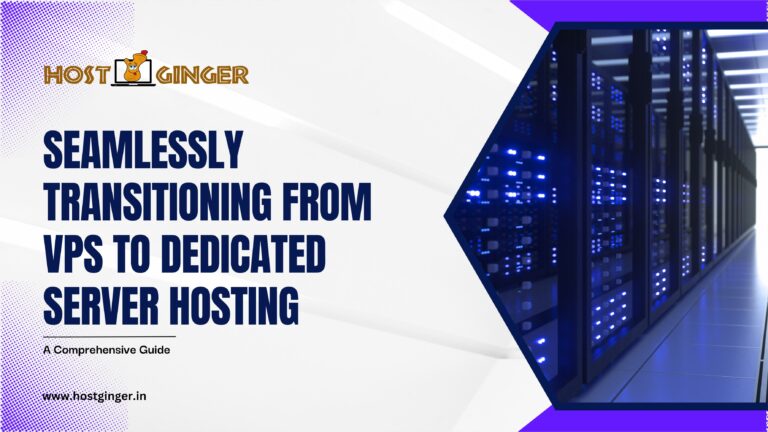Seamlessly Transitioning from VPS to Dedicated Server Hosting: A Complete Information
As your on-line presence grows, the necessity for extra sturdy internet hosting options turns into inevitable. Whereas VPS (Digital Non-public Server) internet hosting gives a steadiness of affordability and management, there comes some extent the place your web site or utility calls for the ability and sources of a devoted server. Transitioning from a VPS to a devoted server is a big step that may significantly improve your web site's efficiency, safety, and scalability. This information will stroll you thru the important steps and concerns for a easy transition.
Select Your Dedicated Server Plan
1. Consider the Want for a Dedicated Server
Earlier than making the change, it’s essential to assess whether or not your present VPS setup is certainly limiting your operations. Key indicators embrace:
• Elevated Site visitors: In case your web site experiences constant site visitors spikes that pressure your VPS sources, it could be time to improve.
• Useful resource Calls for: Functions or web sites with excessive CPU, RAM, or storage necessities could profit from the devoted sources of a server.
• Safety Issues: A devoted server gives enhanced safety features, making it a greater possibility in case you’re coping with delicate knowledge or have particular compliance necessities.
2. Plan the Transition Rigorously
A profitable transition from VPS to a devoted server requires thorough planning. It is best to define the steps concerned and anticipate potential challenges.
• Backup Your Knowledge: Earlier than initiating the transition, guarantee all of your knowledge is securely backed up. This consists of your web site recordsdata, databases, and every other crucial data.
• Schedule Downtime: Relying on the complexity of your web site, you could want to schedule a upkeep window to keep away from disruptions in the course of the transition.
• Select the Proper Server Configuration: Consider your present and future wants to choose a devoted server configuration that provides the fitting steadiness of CPU, RAM, storage, and bandwidth.
3. Set Up and Check the New Server
When you’ve chosen a devoted server, the subsequent step is to set it up and completely check its efficiency.
• Set up Required Software program: Guarantee all essential software program, together with your working system, net server, database server, and every other purposes, are correctly put in and configured.
• Optimize Server Settings: Tailor the server settings to match your particular wants. This would possibly embrace configuring firewalls, optimizing database settings, and organising caching mechanisms.
• Conduct Efficiency Testing: Earlier than migrating your stay web site, conduct efficiency checks to make sure the server can deal with your anticipated load. This might help establish any bottlenecks or points that want addressing.
4. Migrate Your Knowledge
Along with your devoted server arrange and examined, it’s time to migrate your knowledge from the VPS.
• Switch Recordsdata and Databases: Use safe strategies to switch all web site recordsdata, databases, and configurations to the brand new server. Instruments like rsync or FTP might help with file transfers, whereas database dumps can be utilized for migrating databases.
• Replace DNS Settings: After the info migration, replace your area’s DNS settings to level to the brand new server’s IP deal with. Remember that DNS adjustments can take up to 48 hours to propagate totally.
• Check the Web site: As soon as the DNS adjustments have propagated, completely check your web site on the brand new server to guarantee every little thing is functioning appropriately. This consists of checking for damaged hyperlinks, verifying database connections, and making certain all purposes are operating easily.
5. Monitor and Optimize
The transition doesn’t finish with the migration. Ongoing monitoring and optimization are important to guarantee your devoted server is acting at its finest.
• Monitor Server Efficiency: Use monitoring instruments to monitor CPU utilization, reminiscence consumption, and community exercise. This can aid you establish any points and optimize useful resource allocation.
• Safety Hardening: Implement extra safety measures, corresponding to common software program updates, intrusion detection methods, and sturdy firewalls, to defend your server from potential threats.
• Common Backups: Set up a backup routine to safeguard your knowledge. Common backups guarantee that you may rapidly get well within the occasion of information loss or server failure.
6. Consider the Value Implications
Transitioning to a devoted server usually comes with increased prices, however the funding might be justified by the efficiency positive factors and elevated management.
• Examine Hosting Prices: Assessment the pricing construction of devoted servers and evaluate it together with your present VPS prices. Think about any extra bills, corresponding to software program licenses or managed companies.
• Assess the ROI: Think about the potential return on funding (ROI) from improved web site efficiency, higher safety, and the flexibility to deal with extra site visitors. This might help you establish whether or not the upper price is justified.
Conclusion
Transitioning from a VPS to a devoted server is a crucial step for rising companies and high-traffic web sites. By rigorously evaluating the necessity for a devoted server, planning the transition, and implementing finest practices for migration and optimization, you'll be able to guarantee a easy and profitable improve. The improved efficiency, safety, and scalability provided by a devoted server will present a stable basis on your on-line operations, positioning your web site or utility for long-term success.
Source link

